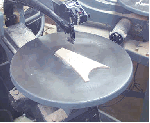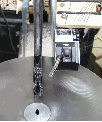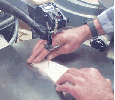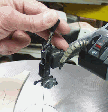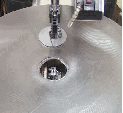I hear the Q3 being a c-arm will not do precision cutting. But I make and design all
my wood gear clocks on it so how much more precision is a person capable of. And I
stack cut thousands of ornaments every year, for the mail order business.
Cutting 2 X 6 pine and thicker wood I feel the Q3 really is great. The aggressiveness
of the c-arm makes it cut the thick wood as easy as a parallel arm saw cuts the 3/4
stuff.
In all I have the Dewalt and the Q3 sitting in my shop. I use the Q3 89% of the time
and the Delta P20 10% of the time.
But again remember I also look for speed, and the aggressiveness of the c-arm will
increase production by at least 25%. A big plus to me!
Just about everything I cut is on the Q3. The wood
gear clocks that I designed and made were on the Q3. The projects like the
Cladesdale Plaque and the Grapevine Hearts in Scrollsaw
Workshop was done on the Q3. I have even made the miniature puzzles with 64
pieces on a 1" square puzzle on the Q3. That makes each piece 1/8" X
1/8" with the tabs and slots a little bigger. I have pictures of them on
my site. Anyway the Q3 will cut anything the other saws on the market will do,
but just faster because of the more aggressive cutting action.
As you have seen on my site I have 9 different
current models of saws to chose from in my shop, even have the Eclipse here,
but I still use the Q3.
I think the C arm saws were bashed back from Pat
Speilmans early books. If he had ever cut on them much I think he would have
found he misrepresented the cutting capabilities of the saw. Some complain of
the undercut, but as I have shown many, that is because the feed the work
right up to the end of the line without slowing down the feed rate to let
the blade catch up. Most seem to feed the wood hard into the blade so there is
a lot of bow in the blade, and when bowed of course the bottom is cutting
farther ahead than the top of the wood section. Feed the wood into a corner
right up to the corner then just stop and hold the wood, The blade will come
about another 1/8" as the bow is straightened out, that is how they get
the undercut they blame the saw for. I can make the parallel arm do the same
thing. But normally the feed rate is slower so there is not as much bow so the
undercut just doesn't show up as easy..
----- Original Message -----
